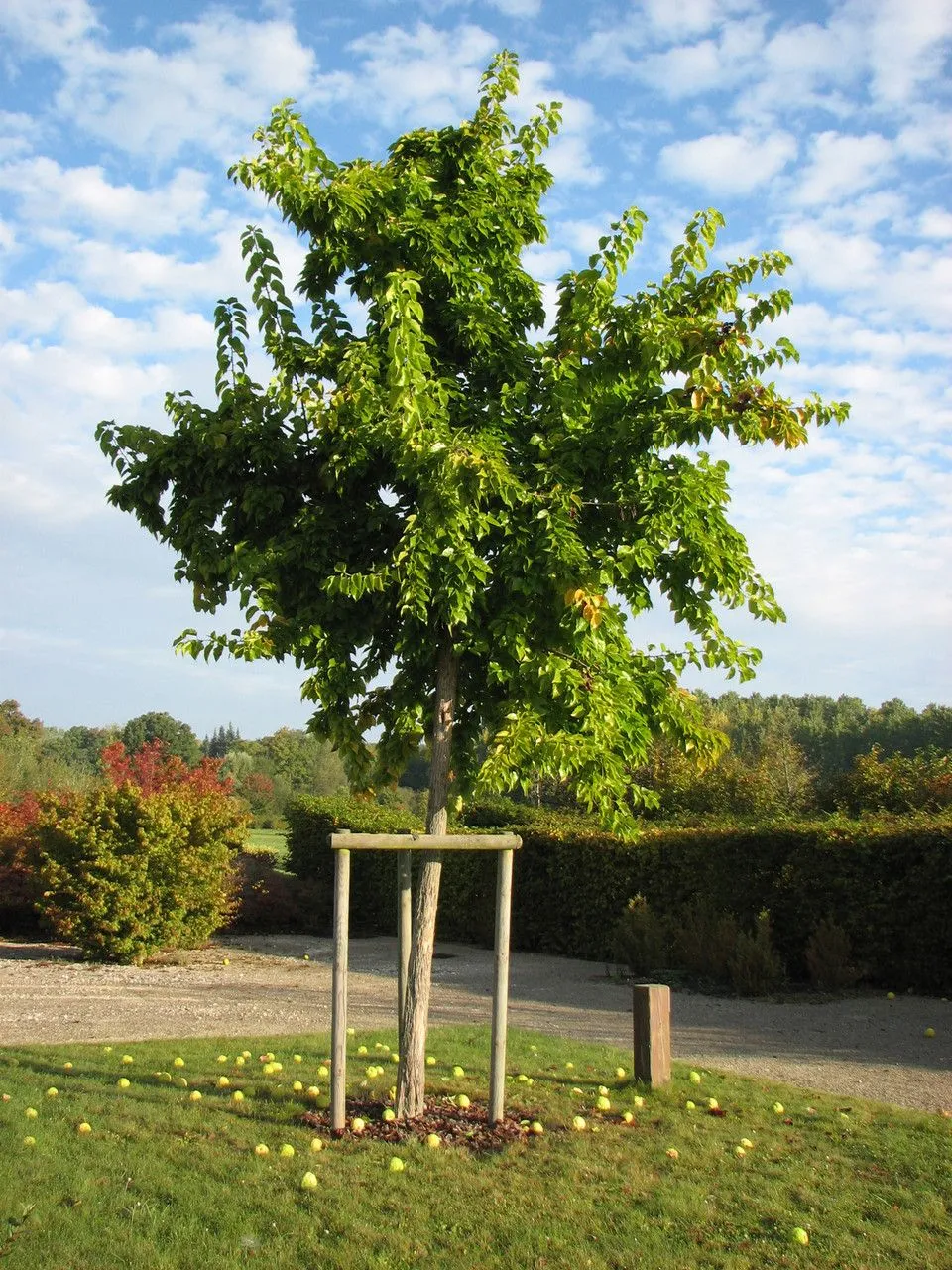
Author: (Raf.) C.K.Schneid.
Bibliography: Ill. Handb. Laubholzk. 1: 806 (1906)
Year: 1906
Status: accepted
Rank: species
Genus: Maclura
Vegetable: False
Observations: SE. Oklahoma to Texas and Arkansas
Osage orange, scientifically known as Maclura pomifera, is a remarkable deciduous tree belonging to the family Moraceae. First described in a detailed botanical text in 1906, Osage orange has continued to fascinate botanists and horticulturists alike.
Native to the southeastern United States, particularly from Oklahoma stretching down to Texas and Arkansas, Osage orange thrives in various landscapes. Its hardiness and adaptability have allowed it not only to survive but to also flourish in a range of soil conditions, from sandy to clayey ones.
This distinctive tree is easily recognizable by its unusual fruit, which is often colloquially referred to as “hedge apple.” These large, green, spherical fruits have a rough and bumpy texture, and while they are not typically consumed by humans, they provide a significant source of food for wildlife.
Historically, the wood of the Osage orange has been highly valued. Indigenous peoples, such as the Osage Nation, utilized the wood for making strong bows, leading to one of the tree’s other common names, bois d’arc, which is French for “bow wood.” Its dense and rot-resistant nature makes it ideal for fence posts and other outdoor structures.
Ecologically, Maclura pomifera serves as an excellent choice for windbreaks and erosion control. When planted in rows, they form dense, natural hedges that can effectively reduce soil erosion and provide shelterbelt protection for other plants.
In contemporary landscaping, Osage orange is sometimes used for ornamental purposes due to its distinctive fruit and glossy, dark green leaves that turn vibrant shades of yellow in the fall. The tree’s unique characteristics and historical significance make it an interesting and valuable addition to both natural and cultivated landscapes.
Deu: apfelfrüchtiger osagedorn, osagedorn
Fra: bois-d’arc, oranger des osages, bois d’arc, maclure épineux, maclure épineuse
Ita: maclura pomifera
Spa: naranjero de los osages, machura, madera de arco, naranjo de los osages
Eng: osage orange, bow-wood, hedge-apple, osage-orange, bodark, bowwood
Swe: citrusmullbär
Por: maclura
Hun: narancseperfa
En: Osage orange, Bow-wood, Hedge-apple, Osage-orange, Bodark, Bowwood, Bow Wood, Hedge Apple
Fr: Bois-d’arc, Oranger des Osages, Bois d’arc, Maclure épineux, Maclure épineuse
De: Apfelfrüchtiger Osagedorn, Osagedorn
Hu: Narancseperfa
It: Maclura pomifera, Gelso dei tintori, Maclura, Moro degli Osagi
Pt: Maclura
Es: Naranjero de los Osages, Machura, Madera de arco, Naranjo de los osages, Maclura tinctorial, Naranjo de Luisiana, Naranjo de Osage
Sv: Citrusmullbär
© copyright of the Board of Trustees of the Royal Botanic Gardens, Kew.
© copyright of the Board of Trustees of the Royal Botanic Gardens, Kew.
© copyright of the Board of Trustees of the Royal Botanic Gardens, Kew.
Taken Jan 15, 2022 by louison jaguelin (cc-by-sa)
Taken Jan 11, 2022 by Patrick Nard (cc-by-sa)
Taken Dec 4, 2019 by Zehra Adilovic (cc-by-sa)
Taken Jan 18, 2022 by pat bal (cc-by-sa)
Taken Nov 3, 2016 by jerc tbm (cc-by-sa)
Taken Oct 11, 2019 by Russelia R (cc-by-sa)
Taken Sep 7, 2020 by b bernoss (cc-by-sa)
Taken Nov 14, 2021 by Cabaca Antonio (cc-by-sa)
Taken Oct 23, 2022 by Lutz Lissy (cc-by-sa)
Taken Aug 15, 2021 by Danilo Brugali (cc-by-sa)
Taken Oct 4, 2021 by isamzpat (cc-by-sa)
Taken Nov 21, 2020 by Delgado Caballero Fran (cc-by-sa)
Taken May 20, 2014 by Tela Botanica − Denis NESPOULOUS (cc-by-sa)
Taken Sep 7, 2020 by b bernoss (cc-by-sa)
Taken Sep 24, 2007 by Tela Botanica − Annick LARBOUILLAT (cc-by-sa)
Taken Sep 28, 2020 by Hoannessian frederic (cc-by-sa)
Taken Feb 4, 2022 by Fabrice Rubio (cc-by-sa)
Taken Sep 2, 2021 by Olivier (cc-by-sa)
Taken Nov 14, 2017 by Tela Botanica − Liliane ROUBAUDI (cc-by-sa)
Taken Oct 23, 2022 by Lutz Lissy (cc-by-sa)
Taken Sep 15, 2003 by Photoflora – Jean-Luc TASSET (©)
Taken Aug 15, 2009 by Photoflora – Jean-Luc TASSET (©)
Taken May 20, 2018 by huy HO (cc-by-sa)
Taken Jan 4, 2022 by Ale Mac (cc-by-sa)
Taken Jun 3, 2022 by malot w (cc-by-sa)
Taken May 16, 2021 by R Dragowski (cc-by-sa)
Taken May 8, 2020 by valérie mc (cc-by-sa)
Taken May 20, 2018 by huy HO (cc-by-sa)
Taken Nov 27, 2019 by Marzanna Bug (cc-by-sa)
Taken Sep 24, 2022 by nature lovers 017 (cc-by-sa)
Growth form: Single Stem
Growth habit: Tree, Shrub
Growth rate: Moderate
Ph maximum: 7.5
Ph minimum: 4.5
Light: 8
Atmospheric humidity: 5
Soil nutriments: 5
Family: Myrtaceae Author: (F.Muell.) K.D.Hill & L.A.S.Johnson Bibliography: Telopea 6: 402 (1995) Year: 1995 Status:…
Family: Rubiaceae Author: Pierre ex A.Froehner Bibliography: Notizbl. Bot. Gart. Berlin-Dahlem 1: 237 (1897) Year:…
Family: Sapindaceae Author: Koidz. Bibliography: J. Coll. Sci. Imp. Univ. Tokyo 32(1): 38 (1911) Year:…
Family: Asteraceae Author: A.Gray Bibliography: Pacif. Railr. Rep.: 107 (1857) Year: 1857 Status: accepted Rank:…
Family: Fabaceae Author: Medik. Bibliography: Vorles. Churpfälz. Phys.-Ökon. Ges. 2: 398 (1787) Year: 1787 Status:…
Family: Aspleniaceae Author: (Cav.) Alston Bibliography: Bull. Misc. Inform. Kew 1932: 309 (1932) Year: 1932…